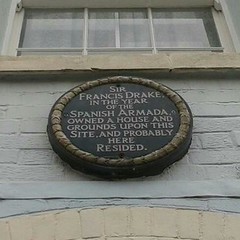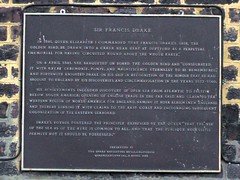Sir Francis Drake
Commemorated on 8 plaques
Sir Francis Drake in the year of the Spanish Armada owned a house and ground upon this site, and probably here resided.
Peacock Lane, Plymouth, United Kingdom where they owned a house and probably lived
Sir Francis Drake In 1581 Queen Elizabeth I commanded that Francis Drake's ship, The Golden Hinde, be drawn into a creek near here at Deptford as a perpetual memorial for having "circuited about the whole earth." On 4 April 1581, she banqueted on board the Golden Hind and "consecrated it with great ceremonie, pompe, and magnificence eternally to be remembered." And forthwith knighted Drake on his ship in recognition of the honouyr that he had brought to England by his discoveries and circumnavigation in the years 1577 - 1580. His achievements included discovery of open sea from Atlantic to Pacific below South America: opening of English trade in the Far East: and claim to the Western region of North America for England. Naming it Nova Albion (New England) and thereby linking it with claims to the east coast and encouraging subsequent colonization of the Eastern seaboard. Drake's voyage fostered the principle expressed by the Queen "That the VSE of the sea as of the Ayre is common to all. And that the publique necessitie permits not it should be possessed."
3 Foreshore, London, United Kingdom where they was knighted by Queen Elizabeth I on his ship The Golden Hinde near here in recognition of the honouyr that he had brought to England by his discoveries and circumnavigation in the years 1577 - 1580 (1580)
St Budeaux Church constructed in 1563 and containing relics from the previous chapel built before 1066. In 1569 Sir Francis Drake here married Mary Newman. The site of two battles during the Civil War when the church was almost destroyed. Restored in 1653
The Green, Crownhill Road, Plymouth, United Kingdom where they married
On this site stood Thornhill House which in 1592 was the property of Edmund Parker and in the occupation of Sir Francis Drake
Hyde Park School, Hyde Park Road, Plymouth, United Kingdom where they lived
Francis Drake sailed from Plymouth on December 13, 1577, to begin the "Famous Voyage" during which he traversed the Strait of Magellan and discovered Drake passage south of Cape Horn. Drake then sailed the Golden Hinde north and in June 1579 landed in California, he took possession of that region for Queen Elizabeth naming it Nova Albion. He returned to Plymouth September 26, 1580, having circumnavigated the globe. Drake was knighted aboard the Golden Hinde at Deptford in the presence of Queen Elizabeth on April 4, 1581. This plaque was presented August, 1977, by the State of California Sir Francis Drake Commission in commemoration of the Quadricentennial of Drake's voyage around the world.
The Hoe, Plymouth, United Kingdom where they was
Tavistock Devon The Western Gateway of Dartmoor Ancient Stannary Town Remains of the Benedictine Abbey founded by Ordgar and Ordulph c965 Gateways part of Cloister Abbot's Hall and Crenellated Wall by River Tavy. Parish Church of St Eustace AD 1185-1450. Interesting Monuments Birthplace of Sir Francis Drake (original statue by Boehm) and of William Browne the Poet. Good Educational Facilities. Hunting. Golf. Fishing. Public Pleasure Grounds. Cricket. Tennis. Bowls &c
Bedford Square, Tavistock, United Kingdom where they was
Tobar an Bháid Drake's Pool The old name, Well of the Boat, was replaced in the 18th century by one relating to Sir Francis Drake , whose ships were said to have hidden here when pursued by a Spanish fleet, in 1588. The Spaniards sailed up Cork Harbour, but missed their prey who who remained unseen here. The Spaniards came out again, Sir Francis stayed for a few days and then left.
Co Cork, Crosshaven, Ireland where they was (1589)
Sir Francis Drake, Corsario Ingles vivio en esta joya colonial ano 1586
English translation: Sir Francis Drake, English privateer lived in this colonial jewel in the year 1586
Calle de los Santes del Piedra, Cartagena, Colombia where they lived (1585)









